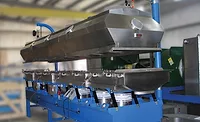Editor's Note
Sustainable solutions offer big challenges to food processors

Smithfield’s biogas recovery project is just one of the innovative solutions processors are using to meet new sustainability challenges.
Photo courtesy of Smithfield Foods
Sustainability is in an interesting place right now.
Most of the low-hanging fruit—LED lighting, variable-speed drives, that kind of stuff—has already been done. Most processors are focusing on energy efficiency in equipment and operations, as well as paying more attention to water.
It’s fair to say that the easy part is over, or at least mostly over. But sustainability isn’t going away because corporate sustainability goals, cost pressures and demands for details about sustainable production and ingredients from consumers are all here to stay. While consumers may not necessarily care (yet) about how much energy your production line is using, they are interested in carbon footprints or the environmental impact of ingredients and products.
With that in mind, we’re taking the opportunity this month to explore different areas of sustainability and how processors are managing them. We’re examining energy efficiency, water efficiency, sustainable packaging and the North Carolina Food Innovation Lab, which was not only designed in a sustainable manner, but also will focus heavily on plant-based products (among many other things), which offer sustainability benefits of their own.
The good news about sustainability getting harder is that it’s leading to a number of creative solutions across the board. And it’s indisputably a good thing that consumers and C-suites are acknowledging the benefits of sustainability and pushing for it in so many ways.
But it’s certainly a challenge, and those on the front lines of production and engineering are feeling the brunt of it. It’s easy for someone to say “let’s be more sustainable” and walk away. For those charged with meeting that goal, it’s a daunting task when all the stuff that easily pencils out has been done. I would imagine that just about everybody reading this is feeling that pressure, or will be soon.
If you are feeling that pressure, I’d like to remind you that you’re not alone. The food industry—and countless others—is facing this challenge at every turn, and food has the added degree of difficulty of baseline requirements for energy and water usage to meet regulatory and food safety requirements.
Now let’s put away the doom and gloom and focus on the bright side. There are people and companies out there coming up with creative, effective solutions that are accomplishing things that we never would have dreamed of just a few years ago. We have examples of them in this month’s stories, as well as previous issues.
They’re all different projects at different companies with different goals, but I want your takeaway to be this: What they all have in common is strong support from company leadership. That’s the critical piece that’s needed, and it has to go beyond “it will pay for itself in X months.”
There are solutions to every sustainability challenge that can be thrown at you, but only if you get the support you need from the top to make it happen. So the next time someone tosses a sustainability requirement at you and starts to walk away, stop them in their tracks and ask them what they’ll do to ensure you have what you need to meet the challenge.
Looking for a reprint of this article?
From high-res PDFs to custom plaques, order your copy today!









